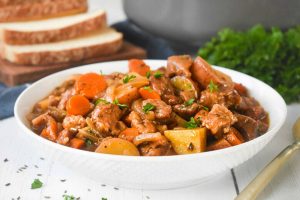Today’s technology makes it possible for farmers in different states to conduct secondary research online in the off-season and put it into practice during the growing season.
“We had a hole in our bean lineup, so I went online and started looking for seed,” says Aaron Prunty, who farms with his dad, John, and his brother, Paul, on the South Dakota-Minnesota border near Pipestone, Minn. “I really liked what I read about Latham Hi‑Tech Seeds in the F.I.R.S.T. Trials and decided to give it a try. In our first year, we planted a plot that included Latham’s 1858 and 1538, which ended up winning. All three of the Latham numbers we planted performed well, and the 1858 out-yielded the competition in every side-by-side we put it in. We decided to plant exclusively Latham® soybeans the next year.”
Aaron is responsible for making the seed decisions for the family’s farming operation. His brother has a real knack for fixing equipment, and their father has been primarily responsible for taking care of their independent farrow-to-finish pork operation.
The Prunty family raises all crossbreds. They save their sows and buy boars: Hamp, Duroc, Large Whites and Yorks. As a result of keeping a fairly closed herd and mixing their own feed on site, they avoided PEDV. They also were one of the first producers to start vaccinating for PRRs.
“We’ve always been farrow-to-finish. We farrow year-round, every week,” says John. “I love farming and that makes all the difference in the world. Fortunately, my wife has been a partner with me through the years.”
John’s wife, Elizabeth, mainly took care of the farrowing barn but now Paul is doing more of that. In fact, each family member is making the most of his natural abilities and interest. Aaron graduated in 2007 from South Dakota State University in Agronomy. Paul earned a degree in Animal Science in 2013 from SDSU.
“I’ve always enjoyed working with Dad. He has a lot of respect for us and our abilities,” says Aaron. “Dad very much leads by example. He doesn’t leave the dirty work just for us; he pitches in. He’s a really good mentor and he’s always been on the cutting edge of technology.”
John says, “It’s really fun farming with the boys. They’re full of shenanigans! I’m transitioning to retirement, but I’m having too much fun to quit.”
While each family member has his or her main responsibility, they all help where needed. John runs the combine, while Aaron and Paul trade off running the grain cart and semis for soybeans. Elizabeth runs the grain cart for the corn harvest. They’ve also divided up the spring field work. Paul does the strip tilling and plants the corn; Aaron plants the soybeans.
You could say that farming is in the Prunty’s blood. They’ve traced their ancestors back to the 1600s and learned they were farmers in Northern Ireland. In honor of the Prunty’s Irish heritage and their love of farming, we’re sharing a recipe for Irish Pork Stew.
Irish Pork Stew
Recipe Yields Serves 8

Ingredients
- 2-pound boneless blade pork roast, cut into 1/2-inch cubes
- 1/3 cup flour
- 1 1/2 teaspoons salt
- 1/4 teaspoon pepper
- 1 teaspoon vegetable oil
- 8 baby red potatoes, quartered
- 4 carrots, peeled and chopped
- 4 large onions, peeled and sliced 1/2-inch thick
- 1 clove garlic, minced
- 1/4 cup parsley, chopped
- 1 teaspoon caraway seed
- 1 bay leaf
- 1 10 1/2-oz can chicken broth
- 1 12-oz bottle imported stout, OR beer
- 2 tablespoons red wine vinegar
- 1 tablespoon brown sugar
Directions
- In a bowl combine flour, salt and pepper. Coat pork cubes with flour mixture.
- Heat oil in Dutch oven; brown meat over medium-high heat. Add onions and garlic. Cook and stir for 5 minutes.
- Stir in remaining ingredients. Bring to a boil and cover.
- Simmer on medium-low heat for 1 hour or until meat is very tender. Stir occasionally.
